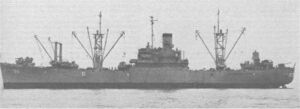USS Marquette (AKA-95)
 Andromeda class AKA, similar to USS Marquette Andromeda class AKA, similar to USS Marquette | |
| History | |
|---|---|
| Laid down: | Unknown |
| Launched: | 29 April 1945 |
| Commissioned: | 20 June 1945 |
| Decommissioned: | 19 July 1955 |
| Struck: | Unknown |
| Fate: | Unknown |
| General Characteristics | |
| Hull type: | C2-S-B1 |
| Displacement: | 6,761 tons |
| Length: | 459 ft 2 in (140 m) |
| Beam: | 63 ft (19.2 m) |
| Draft: | 26 ft 4 in (8.0 m) |
| Speed: | 16.5 knots (31 km/h) |
| Complement: | 247 |
| Armament: | 1 × 5"/38 caliber dual purpose gun mount, 4 × twin 40 mm gun mounts |
USS Marquette (AKA-95) was an Andromeda class attack cargo ship named after counties in Michigan and Wisconsin. She served as a commissioned ship for 10 years.
History
Marquette (AKA–95), built under Maritime Commission contract by the Federal Shipbuilding and Drydock Co., Kearny, N.J., was launched 29 April 1945; sponsored by Mrs. Sydney B. Wertheimer; acquired by the Navy on loan charter from the Maritime Commission 19 June 1945; and commissioned 20 June 1945, Commander John E. Gabrielson in command.
Two weeks prior to the end of hostilities in the Pacific, Marquette departed the east coast for Pearl Harbor. Arriving there 23 August, she loaded cargo for the western Pacific and departed for Guam, 20 September. From Guam she continued on to Manus and Brisbane, where she picked up a cargo of food for the Philippines. Upon arrival at Samar, she discovered her cargo was no longer needed and had been transferred to UNRRA for use in Greece. She then proceeded to Piraeus, via Suez, discharged her cargo, and returned to Norfolk 19 April 1946.
Marquette was then assigned to the Atlantic Fleet and for almost 9 years served as a unit of that fleet’s amphibious force. She participated regularly in type, squadron, and amphibious exercises which ranged from Greenland to the Caribbean. Her activities also included periodic deployment with the United States Sixth Fleet and, 15 August to 21 September 1947, a Brazilian cruise with congressional observers for the Rio Conference embarked. This conference resulted in the signing of the Inter–American Treaty of Reciprocal Assistance, 2 September.
Marquette’s five 6th Fleet deployments, with units of the 2d Marine Division on board, were conducted in 1948, 1949, 1951, 1952, and 1954. During these Mediterranean cruises she operated primarily in the eastern and southern sections of that sea. On her first such deployment, in July 1948, Marquette was the scene of a conference between the U.N. mediator in Palestine, Count Folke Bernadotte, and the commanding officers of units of TF 167 as tension under the newly instituted, and extremely uneasy, truce between Israel, Jordan, and Egypt continued to mount. On each successive deployment she was a source of stability in the troubled eastern Mediterranean.
On 5 January 1955, Marquette departed Norfolk for California. Arriving San Pedro on the 23d, she joined Transport Squadron 7, Pacific Fleet. In mid–January she sailed to San Francisco, where she decommissioned 19 July and entered the Pacific Reserve Fleet. On 9 January 1960, she was turned over to the Maritime Commission and placed in the National Defense Reserve Fleet. Into 1969 she is berthed at Olympia, Washington.
References
- Dictionary of American Naval Fighting Ships (Primary source for this article)